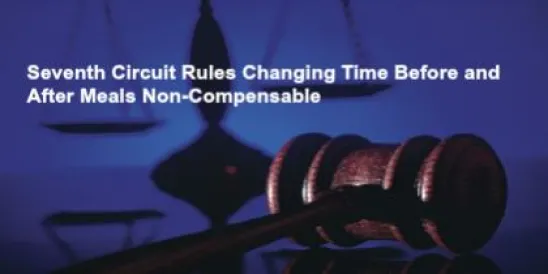The decision details important implications for employers that use deferred compensation arrangements.
The U.S. Court of Appeals for the Fifth Circuit issued a decision on July 14 in Tolbert v. RBC Capital Markets Corp.,[1] holding that a deferred compensation plan through which RBC financial advisors received annual bonuses and made other income deferrals was an “employee pension benefit plan” governed by the Employee Retirement Income Security Act of 1974 (ERISA).[2] The court reasoned that, although the RBC plan’s “primary purpose” was not to provide retirement income, it nevertheless was governed by ERISA because its express terms “result[ed] in a deferral of income by employees for periods extending to the termination of covered employment or beyond.”[3]
ERISA’s “Employee Pension Benefit Plan” Definition
ERISA’s coverage extends to, among other types of plans, “employee pension benefit plan[s].”[4] An employee pension benefit plan, in turn, is defined as “any plan, fund, or program” that, “by its express terms or as a result of surrounding circumstances,” either “(i) provides retirement income to employees, or (ii) results in a deferral of income by employees for periods extending to the termination of covered employment or beyond.”[5]
RBC’s Wealth Accumulation Plan
The plan at issue in Tolbert was RBC’s Wealth Accumulation Plan (WAP). The WAP was a deferred compensation plan through which participants—primarily RBC financial advisors—could defer a portion of their annual pay. It was also the exclusive vehicle through which RBC paid financial advisors annual productivity bonuses.
The WAP’s stated purpose was to allow a “select group of management or highly compensated employees” to defer a portion of their annual pay in an effort to promote “long-term savings and [to] allow such employees to share in [RBC’s] growth and profitability, if any.”[6] The WAP was expressly designed so that, in the event that it was determined to be an employee pension benefit plan under ERISA, it would constitute a “top hat” plan.
The term “top hat” plan is a colloquial reference to “a plan which is unfunded and is maintained by an employer primarily for the purpose of providing deferred compensation for a select group of management or highly compensated employees.”[7] ERISA expressly exempts top hat plans from its vesting, funding, and fiduciary duty requirements.[8]
District Court Proceedings
The Tolbert plaintiffs are former RBC employees who participated in the WAP and who, upon their termination from employment at RBC, forfeited some of their WAP benefits pursuant to the express terms of the plan.[9] The plaintiffs sued RBC for breach of fiduciary duty under ERISA, seeking to recover their forfeited benefits on the theory that the plan was not a valid top hat plan, and, thus, the forfeiture of their plan benefits violated ERISA.[10]
RBC moved for summary judgment on two grounds. First, RBC argued that the WAP was not an employee pension benefit plan under ERISA. Second, RBC argued that, even if the WAP were governed by ERISA, it was a top hat plan exempt from ERISA’s vesting, funding, and fiduciary duty provisions. For their part, the plaintiffs filed a cross-motion for summary judgment, arguing that the WAP was not a valid top hat plan.
The U.S. District Court for the Southern District of Texas granted RBC’s motion on the first issue, holding that the WAP was not an employee pension benefit plan governed by ERISA.[11] In examining the WAP’s express terms, the court reasoned that nothing in the WAP’s provisions reflected a primary purpose to provide retirement or deferred post-termination income.[12] Rather, under the WAP, participants received distributions of their plan benefits promptly upon vesting (while still employed), unless the participant elected in writing to defer distributions until a later date or upon termination.[13]
In reaching its holding, the district court noted that the Fifth Circuit had not previously addressed whether the mere existence of an option to defer income until retirement or post-termination was sufficient to trigger ERISA coverage. In holding that such an option was insufficient to trigger coverage, the district court relied on the U.S. Court of Appeals for the Eighth Circuit’s decision in Emmenegger v. Bull Moose Tube Co.[14] In that case, the Eighth Circuit held that deferred compensation provided through an employer’s phantom stock plan did not trigger ERISA coverage because any deferral until retirement or post-termination periods occurred “strictly at the option of the participant.”[15]
Fifth Circuit’s Opinion
The Fifth Circuit reversed the district court’s holding that the WAP was not an employee pension benefit plan. To begin, the Fifth Circuit addressed its prior precedents, Murphy v. Inexco Oil Co. and Boos v. AT&T, Inc.,[16] in which it reasoned that ERISA’s employee pension benefit plan definition should not be applied in an “‘algorithmic’” fashion or be treated as “‘an elastic girdle that can be stretched to cover any content that can conceivably fit within its reach.’”[17] The court further noted that, under Murphy and Boos, the “words ‘provides retirement income’” in the first prong of ERISA’s employee pension benefit plan definition “‘patently refer only to plans designed for the purpose of paying retirement income whether as a result of their express terms or surrounding circumstances.’”[18]
The Fifth Circuit, however, reasoned that the focus in Murphy and Booson the “primary purpose” or “primary thrust” of the underlying plan was limited to the first prong of the statutory definition. Under that prong, the Fifth Circuit agreed with the district court that the WAP did not, by its express terms, “provide retirement income.” The court noted that (1) the plan’s stated purpose and (2) its express terms providing that benefits would ordinarily be paid out upon vesting and while participants were still employed undermined any suggestion that the plan was designed primarily to provide retirement income.[19]
Turning to the second prong of the statutory definition, the Fifth Circuit disagreed with RBC’s and the district court’s reasoning that, underMurphy and Boos, the critical inquiry is not merely whether the plan resulted in deferral of income until retirement or post-termination insome instances, but rather whether such deferral is the “primary purpose” or “primary thrust” of the plan. Instead, the Fifth Circuit held that the relevant inquiry under the second prong does not concern the plan’s overarching purpose, but simply asks “whether the plan ‘results in a deferral of income by employees for periods extending to the termination of covered employment or beyond.’”[20] According to the court, RBC’s focus on whether the “primary thrust” of the plan was to provide deferred retirement or post-termination income would render the second prong of the statutory definition “superfluous[.]”[21]
After framing the issue in this manner, the court concluded that the WAP’s express terms did indeed result in a deferral of income by employees until retirement or periods beyond termination of employment. Citing a recent U.S. Supreme Court decision that interpreted the term “results” outside of the ERISA context, the court concluded that the term “results” means to “‘arise[] as an effect, issue, or outcome from some action, process or design.”[22] The court reasoned that, under this interpretation, the WAP’s express terms resulted in a deferral of income because they “contemplate[d] employees deferring income ‘to the termination of covered employment or beyond.’”[23]
The Fifth Circuit’s broad, literal interpretation of the second part of the statutory definition departs markedly from the Eighth Circuit’s decision inEmmenegger—holding that a phantom stock plan did not “result in” deferred post-termination income where such deferrals occurred strictly at the option of plan participants—on which both RBC and the district court had relied. Recognizing this departure, the Fifth Circuit distinguished Emmenegger on the grounds that the court’s analysis there was based on the U.S. Department of Labor’s (DOL’s) “bonus program” regulation. That regulation states that the “employee pension benefit plan” definition “shall not include payments made by an employer to some or all of its employees as bonuses for work performed, unless such payments are systematically deferred to the termination of covered employment or beyond[.]”[24] The court explained that the WAP was not a “bonus program” but rather was a self-described “deferred compensation plan,” and, thus, the DOL regulation was inapplicable.[25] The court did not address the undisputed fact that the WAP was the exclusive vehicle through which RBC paid financial advisors annual performance bonuses.
Finally, after holding that the WAP was an employee pension benefit plan, the court noted that “[t]his case does not end [there].”[26] The court pointed out that RBC had presented a potentially dispositive alternative argument that the WAP was an exempt top hat plan. Accordingly, the court remanded the case to the district court for consideration of the top hat issue.
Implications for Deferred Compensation Plans
The Tolbert decision has important implications for employers—particularly in the financial services industry—that use deferred compensation arrangements with an understanding that the particular arrangement does not constitute an ERISA-governed pension plan. The decision also indicates that the DOL’s “bonus program” regulation does not apply to plans that provide bonuses alongside other forms of deferred compensation. Accordingly, employers should carefully evaluate the Tolbert decision and assess how the decision may affect any deferred compensation arrangements they maintain for employees.
Employers should note that although the Tolbert decision is a Fifth Circuit decision, its rationale may have broader applicability. In addition, the decision underscores the importance of properly delineating the top hat group in any ERISA top hat plan—an issue that has itself been the subject of a significant amount of litigation.
[1]. No. 13-20213 (5th Cir. July 14, 2014), available at http://www.ca5.uscourts.gov/opinions/pub/13/13-20213-CV0.pdf.
[2]. 29 U.S.C. § 1002(2)(A).
[3]. Tolbert, No. 13-20213, slip op. at 7–10 (internal quotations omitted).
[4]. 29 U.S.C. § 1002(2)(A).
[5]. Id.
[6].Tolbert, No. 13-20213, slip op. at 3.
[7]. 29 U.S.C. § 1101(a)(1).
[8]. Id. at §§ 1051(2), 1081(a)(3), 1101(a)(1).
[9]. Tolbert, No. 13-20213, slip op. at 5.
[10]. Id.
[11]. The district court did not address the top hat issue on summary judgment. Id.
[12]. Tolbert v. RBC Capital Markets Corp., No. H-11-0107, 2013 WL 3503286, at *6 (S.D. Tex. March 27, 2013).
[13]. Id. at *8.
[14]. 197 F.3d 929, 930 (8th Cir. 1999).
[15]. Tolbert, 2013 WL 3503286, at *8.
[16]. Murphy v. Inexco Oil Co., 611 F.2d 570 (5th Cir. 1980); Boos v. AT&T, Inc., 643 F.3d 127 (5th Cir. 2011).
[17]. Tolbert, No. 13-20213, slip op. at 6 (quoting Murphy, 611 F.2d at 575).
[18]. Id. (quoting Murphy, 611 F.2d at 575).
[19]. Id. at 7.
[20]. Id. at 7.
[21]. Id.
[22]. Id. at 8 (quoting Burrage v. United States, 134 S. Ct. 881, 887 (2014)).
[23]. Id. at 10 (emphasis added).
[24]. 29 C.F.R. § 2510.3-2(c) (emphasis added). The court also concluded that RBC’s and the district court’s reliance on the Eighth Circuit’s decision in Emmenegger was misplaced because that case involved a phantom stock plan that the Eighth Circuit concluded had “set[] up a classic bonus situation,” to which the DOL’s regulation applied. Tolbert, No. 13-20213, slip op. at 11 (internal quotations omitted).
[25]. RBC argued in the district court and on appeal that, although the WAP was not a pure bonus plan because it included bonuses alongside other forms of deferred compensation (e.g., voluntary deferrals), the DOL’s pension plan regulation was nevertheless instructive. That regulation provides that the term “pension plan” does “not includepayments . . . for work performed, unless such payments aresystematically deferred to the termination of covered employment or beyond[.]” 29 C.F.R. § 2510.3-2(c) (emphasis added). The WAP indisputably provided bonus payments for work performed.
[26]. Tolbert, No. 13-20213, slip op. at 12.




 />i
/>i

